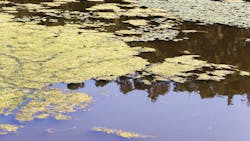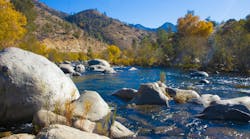Floating filtration technique may soon fight algal blooms
Treating algal blooms and eutrophication can be a complicated and expensive undertaking, but a new method being investigated may cut down on both costs and labor in an environmentally friendly way, according to a press release from Concordia University.
Writing in the journal Water, the researchers describe a system of floating geotextile filters that efficiently remove suspended solids, algae and the nutrients from a shallow lake.
While the project is still in development, the researchers say they believe it has the potential to scale up. This technology could then benefit the health of larger bodies of water such as ponds, rivers, coastal areas and bays.
Over the summer and early fall seasons of 2019 and 2020, the researchers placed six geotextile layers in a floating filtration unit at Lac Caron, Quebec. Lac Caron is a shallow eutrophic lake with a maximum depth of 2.6 meters located in Ste-Anne-des-Lacs, about 75 kilometers north of Montreal. The lake has been under a recreational advisory since 2008 due to excessive algae growth.
The Plexiglas filtration device was made to float by an inflatable rubber tube placed in the center of an enclosed area. The area was cordoned off by using geotextile turbidity curtains. The specialized curtains hang down from the water surface to reach the lakebed, or near to it, to prevent suspended solid interactions with the rest of the lake.
Water samples from the lake and the contained areas were collected every two to three days. The specimens were then analyzed for levels of turbidity, suspended solids (TSS), phosphorus, blue-green-algae-phycocyanin (BGA-PC), chlorophyll-a and more.
The analysis results were encouraging, according to average removal efficiencies in 2019 and 2020. The researchers compared the filtered lake water to the non-filtered lake water and found the following:
- Turbidity reduced 53% in 2019 and 17% in 2020
- TSS by 22% and 36%
- Phosphorus by 49% and 18%
- BGA-PC by 57% and 34%
- Chlorophyll-a by 56% and 32%
PhD student Antônio Cavalcante Pereira says the year-over-year differences are the result of heterogeneous water quality in lakes due to distinct climate and algae growth patterns. A large, visible algae bloom was visible in 2019, while 2020’s algae was more dispersed throughout the whole water body.
“Expanding our system for large lake remediation is a long-term goal. But the novelty of this project is the that we just use the in-situ water filtration as a remediating method for eutrophic water bodies,” says Pereira. “We did not add any chemicals to the lake, but we still managed to get good results: algae suppression and turbidity decreases for an entire recreational season.”
The paper is part of a series that is based on work that first began back in 2008. The project has gone through subsequent iterations over the years and in other lakes in the region.


